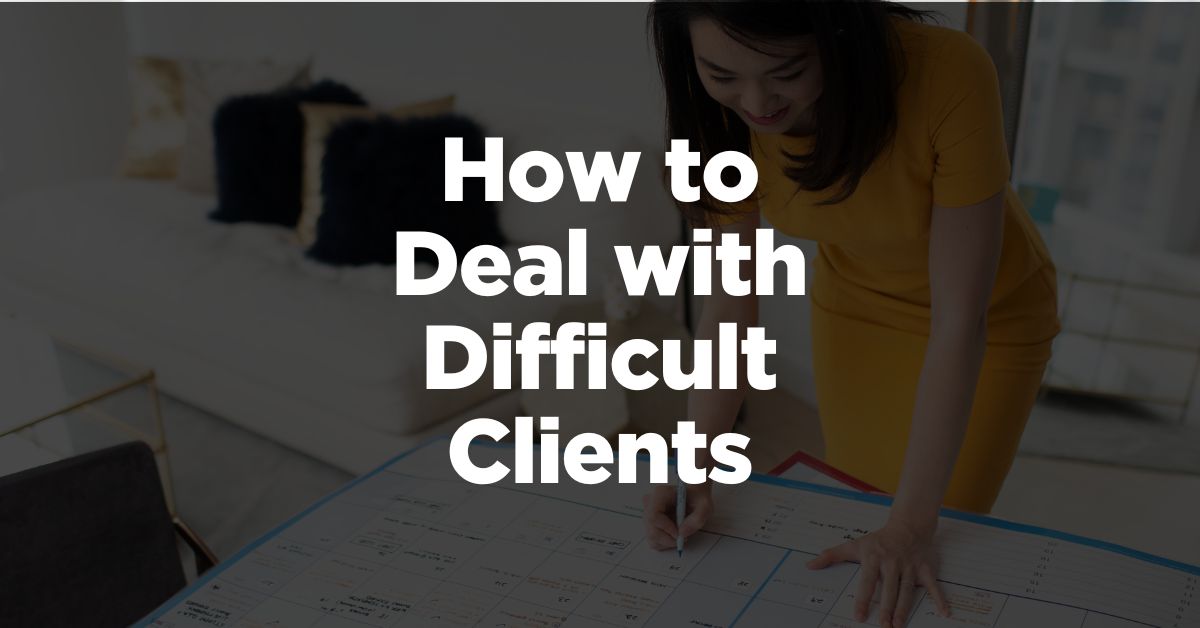Let me guess: You’re a service provider, and you want to learn how to deal with difficult clients – effectively.
Then keep reading.
Here, you’ll learn how to:
- Identify difficult clients before you start working with them
- Avoid difficult clients in 7 steps
- Set better boundaries
Let’s get started!
How do you identify difficult clients?
Often, you can recognize difficult clients before you start working with them.
This comes with practice, but there are certain telltale signs.
For example, someone who focuses more on your refund policy versus your offer is likely not an ideal client.
Why is that a red flag?
Well, this type of client is usually more interested in how much something costs – as opposed to the VALUE they’re going to get in exchange for their investment.
Now, some people genuinely can’t afford to work with you, but that just means they’re not the best fit.
Because remember…
Get the Ultimate Guide
for building a
6-Figure Coaching Business so you can achieve more freedom!
As a service provider, you want to have clients who understand that the price you charge is ultimately an investment that will help them get the results they want.
Speaking of which, another thing you want to look out for is someone who has no idea what they want.
In other words?
They haven’t researched their options or thought about what their end goal is – and how YOU can help them get there.
And… that makes your job a lot more difficult. So, always choose clients who’ve done their homework and know what results they can reasonably expect from working with you.
Alright, now we’ve talked about identifying difficult clients. But especially in the beginning, when you’re learning how to identify difficult clients, you might accidentally agree to work with one. How do you handle them? That’s what we’ll cover next.
How do you handle a difficult client?
In a nutshell, to deal with difficult clients, focus on what YOU can control. Yes, I’ve learned this from experience.
Because even though I’m now a 7-figure business owner and I’ve had amazing clients, I’ve ALSO had bad clients, like this one:
And here are the steps you can take whenever you have a difficult client.
1. Remain calm
Keeping your cool when you’re faced with a client who’s unreasonable, demanding, or just plain rude can be tough.
But the thing is, it’s the best way to de-escalate conflict situations and stay professional.
And… if your client isn’t calm themselves, that’s an even bigger reason to model appropriate behavior yourself.
The best way is to detach yourself from the story. Their reaction has nothing to do with you.
2. Listen to your client
Whenever any kind of client-related problem comes up, it can be tempting to assume your client is at fault.
And you know what?
Maybe they are.
BUT here’s the thing…
Pinning the blame on someone isn’t constructive. If you take the time to listen and try to understand where they’re coming from, though, THAT can make a huge difference.
Ultimately, try to find out what the issue is.
For instance, let’s say a client sends you an email accusing you of not being available enough, despite having agreed to your contract terms.
Imagine what might happen if you took that email as a sign that something else is going on.
For example, maybe your client had a disappointing sales call, or maybe their website is taking longer to finish than they were expecting… and they’re upset because of that.
Remember: Sometimes, people lash out for hidden reasons, and just knowing how to actively listen is a valuable soft skill to have.
In fact, just saying, “I hear you. Do you want to talk more about what you’re struggling with right now?” can help.
3. Reply promptly
When a client tells you about a problem they have by email, send them a reply quickly.
The idea here is to acknowledge that you understand their concern and that you’ll do your best to resolve it for them.
With that said…
I don’t recommend addressing the problem itself by message. Instead, ask them when they’ll have time to talk about it over the phone.
For the initial email, though, here’s a template you can use:
Hi [Client],
Thank you for reaching out about [concern]. I value our relationship and want to make sure I’ve understood your feedback so that I can get this taken care of as quickly as possible.
Could we discuss [concern] next week? I’d be happy to help.
Warmly,
[Your name]
Obviously, you can tweak this template, but here’s the basic idea:
You want to promptly acknowledge what your client is facing while giving both of you the time to think through a solution before discussing it.
4. Be a leader
A lot of people have the wrong idea about running a service-based business. They think their job is to serve their clients. And you know what?
It’s not.
Let me explain…
When you’re working with clients as a coach or consultant, for example, you’re there to guide them to a specific result.
After all, they’re coming to YOU because you have the knowledge and experience they don’t yet have themselves.
And that means your role is to help them grow by leading them, not by serving them where they’re currently at.
Ultimately, perceiving yourself as a leader will also help your clients see you as an authority figure who can actually help them.
How exactly do you lead your clients?
For example, take that person from our last example who wants to know why you’re not more available.
Instead of immediately giving up on them, coach them through your conflict. They have their own fears and challenges and you can help them get past those.
5. Communicate effectively
According to a study, empathy is one of the keys to effective communication.
And that makes sense…
If you take the time to put yourself in your client’s shoes and try to understand where they’re coming from, it’ll be a lot easier to find a solution.
But how effectively you communicate can depend in part on what your communication style is.
Because here’s the deal…
We all have different ways of communicating. Some people avoid conflict at all costs, and others seem to go looking for it.
Of course, no communication style is perfect. But if you know how you naturally approach conflict, that can help you adapt your approach as needed.
Ultimately, constructive communication is effective communication.
You and your client have the same goal, so sometimes it’s all about reminding them of that. Either way, be frank and know your boundaries (which you’ve established in your contract).
Get the Ultimate Guide
for building a
6-Figure Coaching Business so you can achieve more freedom!
6. Be candid
Look, if you’re a coach or consultant, part of your job is to give people tough love… NOT tell them they have nothing to change.
Because the reality is, if your clients are coming to you for help, it means they aren’t doing everything right – and they already know that.
So, don’t be afraid to call out complaining and help people focus on their ultimate objective.
For example, maybe you have a client who likes to vent about how they’re not seeing the results they want.
But you know what?
Venting in itself won’t help them move forward. On the other hand, refocusing and taking a closer look at what might be preventing them from making progress will.
7. Let your client go
In some situations, talking with your client won’t lead to a solution.
And that’s because people just aren’t always on the same page about how to move forward.
But you know what?
That’s okay. Be willing to let your client go.
And yes, I know what you’re thinking…
“Luisa, I’m scared that if I stop working with a client, I won’t find another one.”
Listen, if you’re a new business owner and you don’t have a lot of experience yet, that’s totally understandable.
But remember…
Many people need what you offer.
Just because it doesn’t work out with one client doesn’t mean it will never work out.
In fact, by letting go of a client who’s not a good fit, you’ll be able to make room for other clients who will be.
You need to get out there and do the work to get your next clients. A good way to do so is to set up daily sales activities – which you do every day, no matter what.
Alright, now that we’ve talked about how to handle a difficult client, how can you AVOID this type of client in the first place? Let’s talk about that.
How do you avoid difficult clients?
Here are some basic steps to take.
1. Set boundaries
What is the first step you should take when dealing with difficult clients?
Simple: Set boundaries from the start in your client contract.
For example, if your contract says that you don’t work on weekends, don’t feel obligated to respond to “urgent” questions they have on a Saturday.
Again, keep in mind that you’re the leader, and it’s your job to be assertive and protect your time so that you can be fully present to your clients during working hours.
2. Set expectations
Some people might have unrealistic expectations about what you can help them attain.
And… that’s why it’s really important to talk about this upfront.
For example, if you’re a fitness coach, you might have someone come to you and say they want to get six-pack abs in seven days.
Now, look: I’m all for having big goals.
In fact, I’ve helped thousands of students reach their objectives, like this one:

But when expectations are too high, that can lead to a lot of disappointment.
That’s why you want to work with clients who understand that progress takes time and who are willing to put in the work on their end to see results.
So, if you’re a coach, a good idea is to have a contract in writing that makes it clear that you can’t guarantee results. Ultimately, it’s up to your clients to implement what you teach them.
3. Share content
Sharing valuable content for free is a great way to find people who connect with you and your “secret sauce” for getting results.
Now, you can share content under all kinds of forms, like blogs, videos, podcasts, etc. The key is being consistent and finding a channel that works for YOU.
And here’s the thing: When you share great content, it’s easier to filter potential clients.
Here’s what I mean by that…
Some people will discover your content, see the value you offer, and think, “THIS person gets me. I want to go a step further and work with them.”
On the other hand, some people won’t be interested or ready to take that step.
And as I said earlier, that’s okay. Those people aren’t your ideal clients anyway. Just focus on the people who are.
4. Fill up your pipeline
Ultimately, it’s a lot easier to say no to clients who aren’t a good fit if you have other options.
And the good news is, as you gain experience and work with more and more clients, you’ll have a lot more control over who you work with.
In other words?
You won’t feel you have to say yes to anyone just to pay your bills. If you notice red flags in a potential client, you’ll be able to confidently turn them down.
Alright, difficult clients come in a variety of forms, so let’s take a closer look:
Get the Ultimate Guide
for building a
6-Figure Coaching Business so you can achieve more freedom!
Different types of difficult clients
What makes a client difficult to work with? If you don’t want to deal with difficult clients, you need to know what to watch out for. Here are a few signs a client is difficult:
Demanding clients
These types of clients don’t take no for an answer. They want things done in a specific way, even if you KNOW that what they ask for isn’t reasonable or the most effective option.
In other words, they think they know best… even if they’re technically turning to you because YOU know best.
For example, they might send you tons of “urgent” messages on a weekend, or they’re never happy with what you do for them.
Indecisive clients
One minute, your client knows what they want, and the next… they’re not sure.
Maybe you’ve talked to them about what their pain points are and you’ve suggested a solution, but they’re still undecided.
And look, some people need time to make a decision. That’s okay.
But just keep in mind that this type of client can be tough to work with.
As I talked about earlier, make sure your client knows what they need – and how you can help them – before you start working together.
Unrealistic clients
Sometimes, you might have a client come to you with a huge goal they want your help attaining.
And that’s great!
But… if your client’s goal is unrealistic, there’s a risk they’ll get frustrated that things aren’t happening as quickly as they wanted.
For example, losing 50 lbs is possible, and if that’s your specialty, you can help someone get there.
But… expecting to lose that amount of weight in two weeks isn’t reasonable. So, if they come to you with that expectation, help them re-examine their goals.
Clients who demand a refund
For one reason or another, some clients will demand their money back… after agreeing to work with you.
Maybe they’ll claim they aren’t getting the results they were expecting, can’t afford it, or just don’t have the time.
Whatever it is, make sure you’re prepared for this situation. For example, you absolutely CAN have a no-refund policy, which is what I recommend.
That way, you’ll still get paid for committing to working with someone, even if they bail unexpectedly.
Next steps
Alright, there you have it!
Now you know how to deal with difficult clients effectively.
And that’s great because ultimately, nailing client relationships is one of the keys to building a loyal client base, expanding your reach, and yes, making more money.
But to build a business that consistently attracts the right clients, you need the right strategy.
Want to know what it is?
I’m giving you FREE access to my blueprint:

Want to Build a 6-Figure Coaching Business So You Can Achieve More Freedom?
When you sign up, you’ll also receive regular updates on building a successful online business.
Read more:








